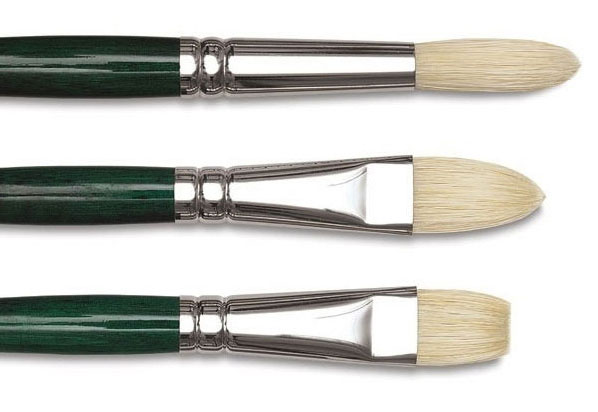Stiff vs. Soft

One thing I learned is the difference between stiff bristle brushes and softer synthetic brushes. Bristle brushes offer more durability and can put up with a bit of abuse. They’re great for filling in large areas quickly and for scrubbing, scribbling and scumbling. Softer brushes tend to be more fragile and must be treated with more care. They excel in smooth paint application, glazing and softening effects.
Brush Shapes
I also discovered some things about different brush shapes. And my experience revealed that flat brushes offer a full range of application possibilities without the need for other brush shapes. Using just a flat brush, a painter can make a surprising number of different marks including:
• filling in large areas with the wide flat side
• making thin lines with the long narrow side
• sharply dividing shapes with the narrow flat tip
• making small detail marks with the corners
You may ask, “Don’t you need other brushes like rounds, filberts and brights?” In my opinion, the detail marks that can be made with the corners of a flat brush eliminate the need for a round brush. I don’t need to buy filberts because my flats eventually turn into filberts as they wear down. And brights simply don’t hold enough paint for me and also lack the bounce of longer flat brushes.
My Brushes of Choice
As a result of these discoveries, flat brushes have become my brushes of choice and the majority of my paintings are completed with just two types: the hog bristle long flat and the synthetic long grainer.
The Hog Bristle Long Flat
The flat hog bristle is quite versatile. It can hold a lot of paint for thick impasto work or be used to paint thin washes. It has a nice springy quality. For years I used this brush exclusively, but at this point I do about 80% of each of my paintings with long flat hog bristle brushes. I use sizes 2 – 12 in these brushes: Trekell Hog Bristle Long Flats, but occasionally use larger sizes in other brands for larger paintings (my largest is a size 35!).
The Synthetic Long Grainer
The softer long flat brushes I use are synthetic hair that’s made to perform like natural mongoose hair. The softness of these brushes offers the ability to lay down thick paint on top of an already thick stroke without digging into the lower stroke the way the stiffer hog bristle would. They’re also great for softening edges and for detail work. I mainly use these for finishing effects as I approach a painting’s completion. I use sizes 1/8″ – 1/2″ in these brushes: Trekell Legion Long Grainer.
Trekell has a brush set available for purchase under my name that contains these brushes I recommend: Dan Schultz Trekell Brush Set.
Special Effects: Occasionally, I employ a brush called an egbert. It’s an extra long hog bristle filbert that can hold a lot of paint and has an extra measure of bounce. After a lot of use, egberts also develop a ragged character that makes for some fantastic brushwork. I mainly use them for a few final, strategically-placed strokes of thick impasto.
I’ll also occasionally use a palette knife or paper towel for certain effects, but I’m admittedly mostly a brush painter. (Although you’ll often catch me at plein air painting shows touching up paintings with my fingers after I’ve put my brushes away. But I usually end up just getting them out again because I haven’t figured out how to make convincing brush strokes with my fingers.)
Write your awesome label here.
